Highlights
from the recent catalogue
Every Picture tells a Story
Click
on a thumbnail (above) to link
directly with the entry for that print,
or scroll down to view this selection from the Every Picture tells a Story catalogue.
Images are not at very high resolution.
If you require further information on any print featured here, please contact
us.
Click
these links to
view a selection of prints from other previous
catalogues:
"Graphic
Alchemy" and "The
Romantic Eye"
Some
of these prints – and others from
the catalogue – may since have been sold.
These
are marked as Sold.
Every Picture Tells a Story
|
|
See
also :
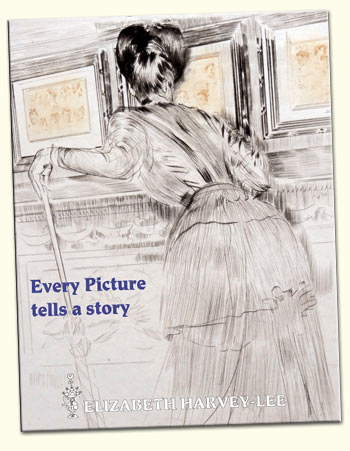
For
further information about Every
Picture tells a Sory, please
view the dedicated page within the Catalogues section.
Printed copies of the Catalogue, published
in summer 2013, are still available, priced £12
(UK) and £16 (International orders)
This
is the third and final page of images selected
from this catalogue. Click
here to view the previous (second) selection
from this catalogue. |
|
|
|
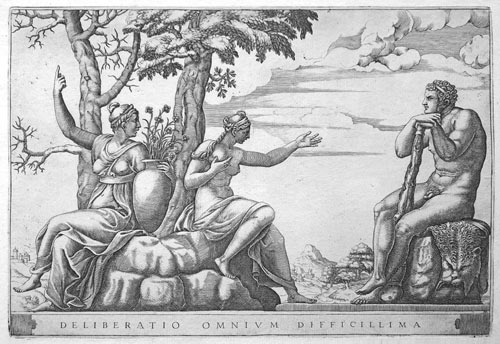 |
|
ADAMO SCULTORI
Active c1547 – 1587
The
son of Giovanni Battista Scultori, trained
by his father in Mantua, and also involved
in the decorations of the Palazzo del Te
designed by Giulio Romano, Adamo settled
in Rome about 1566 as an engraver and printseller.
The
Choice of Hercules
(Hercules at the Crossroads)
Bartsch 26
194 x 287 mm
Engraving, after Giulio Romano.
Signed with the AS monogram.
A good later impression, with margins.
Good condition.
A script ink number 3 in the
top right margin 9 mm from the platemark.
£1500
The
young Hercules, identified by both his customary
attributes, sitting on the bearskin (that
of the Nemean lion which he strangled in
his first Labour) and leaning on his club
(symbol of strength), deliberates the difficult decision between
the paths offered by Virtue and Vice.
Return to top
^ |
|
|
|
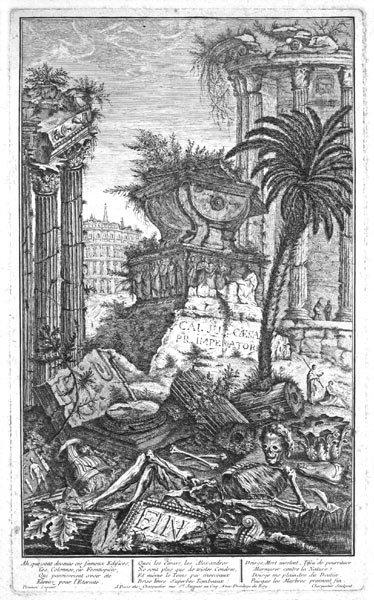 |
|
FRANÇOIS PHILIPPE CHARPENTIER
Blois 1734 – 1817 Blois
Engraver,
inventor and ‘Mécanicien de Roi’, Charpentier published his own prints from the rue St Jacques au Coq, Paris.
Fin (The End)
A caricature ‘Vanitas’ based
on Piranesi
Ex Le Blanc; ex Portalis & Béraldi
355 x 215 mm
Etching, c1757, after Piranesi.
Lettered with Piranesi’s and Charpentier’s names, Charpentier’s address, and verses in French.
On laid paper with a proprietary watermark.
With margins 11mm and wider.
Slight pale foxing and other stains.
£1250
Piranesi’s etching, c1743, Vestigi
d’antichi Edifici (Robison 16), an imaginative arrangement of various Roman remains, is lettered with a factual caption listing some of the actual fragments, including the round Temple of Vesta. The tomb is specified as that of Marco Agrippa (“today serving as the sepulchre of Pope Clement XII”, who had died in 1740).
For
his own version Charpentier adopted, in reverse,
the Temple of Vesta, the palm tree and the
tomb (though altering the inscription on
the tomb to commemorate Julius Caesar) and
added the Colisseum and further fragments
of Roman ruins, including a stone carved
with the French word “Fin”, which stands as a title. He also introduced the smiling, reclining human skeleton.
A
sense of the passage of time and the decay
of a glorious civilisation is incidentally
inherent in Piranesi’s romantic composition but Charpentier humorously makes it the subject of his print, symbolic of the inevitability of human mortality, underlined by the French verses beneath.
Ah,
que sont devenus ces fameux Edifices,
Ces
Colonnes, ces Frontispicès (sic),
Qui paroissoient avoir été
Elevez pour l’Eternité
Quoi les Césars, les Alexandres
Ne sont plus que de tristes Cendres,
Et meme le Tems (sic) par marceaux
Brise leurs Superbes Tombeaux!
Dois-je Mort insolent, Tissu de pourriture
Murmurer contre la Nature?
Dois-je me plaindre de Destin,
Puisque les Marbres prennent fin.
Return to top
^ |
|
|
|
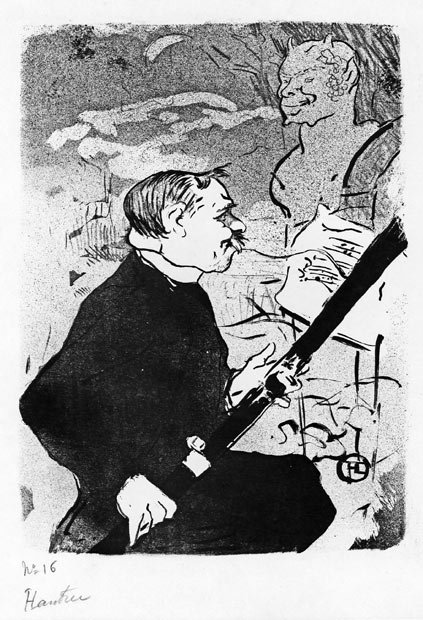 |
|
HENRI
DE TOULOUSE-LAUTREC
Albi 1864 – 1901 Chateau de Malromé, Gironde
The
music publisher Gustave Ondet lived in the
same building which housed the Ancourt lithographic
printing works. He took up the suggestion
to have song titles designed by contemporary
artists whose lithographs were printed by
Ancourt.
Lautrec
designed the cover and five of the collection
of ten songs for Ondet’s Les Vieilles
Histoires, poems by Jean Goudezki set
to music by Désiré Dihau.
Désiré Dihau (1835-1909) was a distant cousin of Lautrec. Bassoonist with the Paris Opéra orchestra, Dihau composed melodies for cabaret songs in his free time.
Jean
Goudezki (really Edouard Goudez, 1866-1934),
a poet and chansonnier, frequented the cabaret
Le Chat Noir. He invented the holorine form,
sonnets of homophones, which he sang in a
deep solemn monotone.
Pour
Toi
Delteil 19 i/ii, Wittrock 6 i/iii, Adriani
28
270 x 192 mm
Original lithograph, 1893, a song title for
the series Vieilles Histoires.
First state,
without text.
First edition, printed in black
ink.
Signed in pencil and numbered 16, from
the total edition of 100 (20 on japan, 40
on chine and 40 stencilled with colour by
another hand).
One of the first 20 impressions,
on simile Japan paper.
Faintly time-stained.
£5500
A
portrait of Désiré Dihau, a variation on and homage to Edgar Degas’ 1868 portrait of the bassoonist in L’Orchestre de l’Opéra. The Degas painting hung in Dihau’s apartment (it is now in the Musée d’Orsay) and Lautrec visited his cousin frequently to look at it.
Return to top
^ |
|
|
|
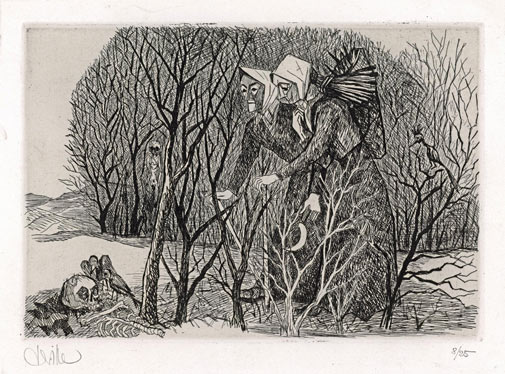 |
|
JEAN DEVILLE
Charleville, Ardennes 1901 – 1972
Initially
trained as a painter with Maurice Denis,
Deville took up etching in 1931. His graphic
work reveals aspects of expressionism, surrealism,
satire and an awareness of human mortality.
Ramasseurs
de fagots
158 x 229 mm
Original etching.
Signed in pencil and numbered 8 from the edition
of 25.
On Rives stout wove paper.
Sold
Out
collecting kindling, two women encounter
two skeletons in the woods.
Return to top
^ |
|
|
|
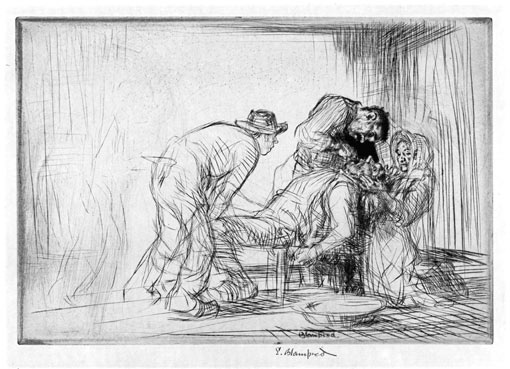 |
|
EDMUND
BLAMPIED R.E.
Ville Brée, Jersey 1886 – 1966 St Aubin
Though he was settled in London, Blampied’s prints drew on his childhood memories of life in his native Jersey, viewed with humorous affection.
The
Farmer Dentist (4th plate)
Dodgson 98
179 x 260 mm
Original drypoint, 1925.
Signed in pencil. Edition of 100.
On laid paper. Time-stained verso.
Sold
The
subject gave Blampied some trouble, his first
three attempts remained unfinished. Only
this fourth plate was completed and published.
Return to top
^ |
|
|
|
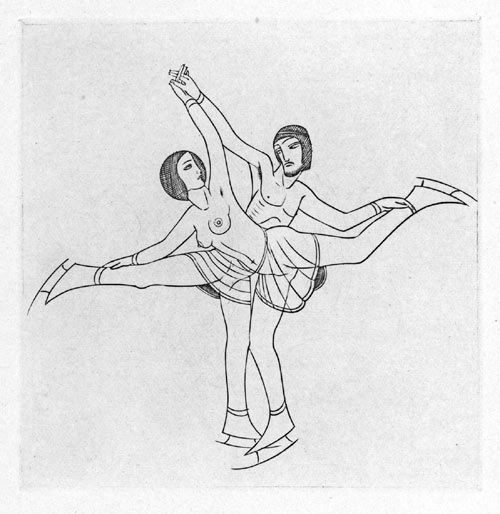 |
|
ERIC
GILL
A.R.A.
Brighton 1882 – 1940 Uxbridge
Skaters
Skelton 368 ii/ii
110 x 110 mm
Original copper line engraving, 1926.
Second
state, the skaters clothed.
From the Cleverden
re-issue, unsigned, 1929. (Page number 83
in the margin, top right corner.)
Sold
Adapted
from a photograph in the Daily Mirror of
two men skating. In the first state the figures
were entirely nude.
Return to top
^ |
|
|
|
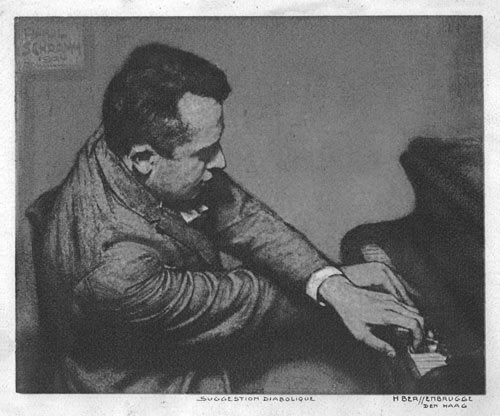 |
|
HENRI BERSSEMBRUGGE
Rotterdam 1873 – 1959 Goirle
A
noted Netherlands photographer, who opened
his studio in The Hague in 1921 and exhibited
widely internationally in the following years.
Suggestion
Diabolique
239 x 300 mm
Original gum spirit photograph, 1926.
Signed in ink and entitled.
Printed on thick cream textured wove paper.
Sold
An
official printed label on the reverse.
This
print was hung at the Scottish International
Salon of Pictorial Photography / Peoples
Palace / Glasgow 1926 / Dec – Jan 1927.
A portrait of the Viennese-born pianist Paul
Schramm, at the height of his powers in 1924.
Prokofiev’s Suggestion
Diabolique , fourth
of ‘Four Pieces’ - Opus 4, composed 1908, starts
with the left hand crossing over the right.
Return to top
^ |
|
|
|
 |
|
BRUNO GORLATO
Born Padua 1940, Died Padua April 2021
Gorlato
trained both as a painter and architect in
Venice and lived and worked in his native
city of Padua until his death in April 2021.
His
prints, dreamlike ‘metaphysical fables’ (as one of his exhibitions was called), with imagery frequently drawn from chess, are inspired by the historical architecture, characters, events and literature of the Veneto.
A reminder that in Italian cities, perhaps more than anywhere else in Europe, the past is palpably present.
Per
un concerto al chiaro di luna
For a concert
by moonlight
295 x 245 mm
Original etching with aquatint, 2012.
An artist’s proof.
Signed in pencil, dated, entitled and annotated, as usual.
On smooth wove.
£350
Return to top
^ |
| |
|
Click
here to view the previous (second) selection
from this catalogue,
or here for the first section. |
|
|
|
|
|
|
|